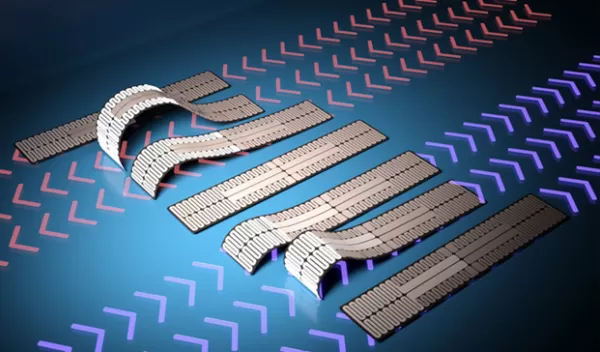
Robot caterpillar demonstrates new approach to locomotion for soft robotics
Researchers at North Carolina State University have shown that a caterpillar-like soft robot can move forward, backward and dip under narrow spaces. The caterpillar-bot's movement is driven by a novel pattern of silver nanowires that use heat to control the way the robot bends, allowing users to steer the robot in either direction.
The study is published in Science Advances and received funding support from the U.S. National Science Foundation via multiple grants.
"This research demonstrates the potential of advanced engineering solutions that experts from nontraditional disciplines."
"A caterpillar's movement is controlled by the curvature of its body — its body curves differently when it pulls itself forward than it does when it pushes itself backward," says NC State's Yong Zhu, corresponding author of the paper. "We've drawn inspiration from the caterpillar's biomechanics to mimic that curvature, and use nanowire heaters to control similar curvature and movement in the caterpillar-bot."
The caterpillar-bot consists of two layers of polymer, which respond differently when exposed to heat. The bottom layer shrinks, or contracts. The top layer expands. A pattern of silver nanowires is embedded in the expanding layer of polymer. The pattern includes multiple lead points where researchers can apply an electric current. They then control which sections of the nanowire pattern heat up by applying an electric current to different lead points, and control the amount of heat by applying more or less current.
"Engineering soft robots that can move in two different directions is a significant challenge in soft robotics," Zhu says.
The researchers demonstrated that the caterpillar-bot's movement could be controlled to the point where users are able steer it under a very low gap — such as guiding the robot to slip under a door. The researchers could control both forward and backward motion, and how high the robot bends upward at any point in the process.
"This approach to driving motion in a soft robot is very energy efficient, and we're interested in exploring ways that we could make this process even more efficient," Zhu says. "Next steps include integrating this approach to soft robot locomotion with sensors or other technologies for use in applications such as search-and-rescue devices."
Siddiq Qidwai, an NSF program director, said that "this research demonstrates the potential of advanced engineering solutions that experts from nontraditional disciplines, such as mechanics of materials, are bringing to the interdisciplinary field of soft robotics."
Added NSF program director Debora Rodrigues, "Such research and bio-inspired design could have applications beyond the lab for tremendous impact. For example, NSF is supporting research to find out whether this technology could be used in wearable motion tracking in sports or health applications."
